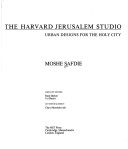Modern Jerusalem is one of the most fascinating laboratories for urban development. These studies, conducted in 1980-1984 by teams of faculty, students, consultants, and advisors from the Jerusalem planning community and the Harvard Graduate School of Design, provide a unique sense of Jerusalem's natural and built environment, its livability, cultural diversity, and political and religious tensions. The more than 500 illustrations include contemporary plans and drawings as well as lithographs, engravings, and historical material that convey the special quality of the Holy City.Moshe Safdie, who initiated and directed the Jerusalem studio, discusses the urban design program at Harvard in his introduction to the book. In the first three chapters, he traces Jerusalem's heritage, presents the Old City and its visual basin, and details projects for Damascus Gate (where "all the ingredients, problems, and opportunities that have made urban design a necessary activity are demonstrated").The remaining chapters focus on the forces of change and how to plan for explosive growth in the new city outside the wall. They present plans for the downtown or central business district, the new satellite towns to the north and south, and the green belt surrounding the city. A final chapter returns to Damascus Gate and presents designs for the no-man's-land, (known as the Seam) outside it. This strategic parcel of land links the Arab and Israeli business districts and the Old City markets. Working with local communities and the municipality, three GSD graduates developed the design that was given the first Progressive Architecture Urban Design Award in 1985. So compelling was this proposal that the municipality intends to implement it.The Jerusalem studio program was not only pedagogically significant but also of great practical value for the city of Jerusalem. The teams shed light on the opportunities and predicaments of a great historic city undergoing rapid growth and development and offered some brilliant design strategies. While the studies focus on Jerusalem, the issues they address - such as how new development can be made to harmonize with historic architecture and the impact that new commercial centers have on a strongly divided population - are relevant to many cities.Moshe Safdie is Ian Woodner Studio Professor of Architecture and Urban Design at Harvard University, where he was Director of the Urban Design Program at the Graduate School of Design from 1978 to 1984. His previous books include "Beyond Habitat, For Everyone a Garden," and "Form and Purpose."
- ISBN10 0262192470
- ISBN13 9780262192477
- Publish Date 16 January 1987
- Publish Status Out of Print
- Out of Print 5 August 2011
- Publish Country US
- Publisher MIT Press Ltd
- Imprint MIT Press
- Format Hardcover
- Pages 336
- Language English
